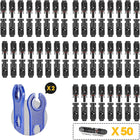Exploring the Great Outdoors: What is Dry Camping?

Wake up to the soothing sounds of nature, with the first rays of dawn peeking through your tent or RV window. This immersive outdoor experience is what draws many adventurers to dry camping, a form of camping that's as raw and genuine as it gets.
But what exactly is dry camping, and why is it becoming an increasingly popular way to retreat from the hustle and bustle of daily life? Whether you're a seasoned camper or new to the world of outdoor escapades, let's dive into the essentials of dry camping and how you can prepare for your own off-grid adventure.
Understanding Dry Camping
Dry camping, also known as boondocking or wild camping, refers to camping without any hookups for water, electricity, or sewage disposal. This means you're completely self-sufficient, relying on what you bring along in your RV, van, or backpack. Dry camping can take place on public lands like national forests and Bureau of Land Management (BLM) areas, or at designated campgrounds that offer "primitive" or "no hookup" sites.
The Appeal of Dry Camping

So why do campers choose to go dry? The answer lies in the simplicity and freedom it offers. Dry camping allows you to connect with nature on a deeper level, devoid of distractions like technology and modern conveniences. It's also less expensive than staying at a campground with full hookups, and often you'll find yourself in more secluded and scenic locations. Plus, for those who value sustainability, dry camping encourages a lighter environmental footprint.
Preparing for Dry Camping

Despite its many perks, dry camping requires thorough preparation to ensure a safe and enjoyable experience. Here's what you need to keep in mind:
1. Water Supply: Since there won't be a readily available water source, you must pack enough potable water for drinking, cooking, and cleaning. A good rule of thumb is to have one gallon per person per day.
2. Power Sources: While you won't have electrical hookups, there are alternative power sources you can use. Solar panels and portable power stations can provide electricity for essential devices.
3. Waste Disposal: Plan for proper waste disposal. Bring trash bags for litter and have a strategy for human waste if there are no facilities nearby. Portable toilets and waste bags specifically designed for camping can be very useful.
4. Food Storage: Without access to a refrigerator, you'll need to think about how to store food safely. Coolers with ice packs or a portable fridge/freezer that operates off your alternate power source can help keep perishables fresh.
5. Navigation Tools: As dry camping often occurs in remote areas, GPS devices and paper maps are crucial. Ensure that you know how to navigate your surroundings and plan your route ahead of time.
6. Emergency Supplies: Always pack a well-stocked first-aid kit, a repair kit for gear, and emergency items like a whistle, fire extinguisher, and extra batteries.
Choosing the Right Location
Selecting the perfect spot for dry camping involves research. Look for areas where it's legal and safe to camp. Public lands often allow dispersed camping outside of developed campgrounds, but always check the specific regulations for the area.
Additionally, consider the terrain, weather conditions, and any wildlife you may encounter. Some websites and apps specialize in helping dry campers find suitable locations.
Staying Safe and Responsible

Dry camping comes with responsibilities to both yourself and the environment. Here are some guidelines to follow:
- Follow Leave No Trace principles to minimize your impact on natural surroundings.
- Stay aware of fire restrictions in the area, and never leave a campfire unattended.
- Keep a respectful distance from wildlife and avoid feeding animals.
- Be conscious of noise levels; excessive noise can disturb both wildlife and other campers.
- Secure your food and trash to prevent attracting critters.
- Make sure your campsite is allowed by checking local rules and regulations.
Tips and Tricks for an Optimal Dry Camping Experience
- Start Small: If you're new to dry camping, try a short trip close to home to get a feel for what it's like to camp without amenities.
- Pack Efficiently: Space is limited, so bring only what's necessary. Multi-purpose items save space and weight.
- Conserve Resources: Practice conserving water and power. For instance, use a spray bottle to clean dishes instead of running water.
- Stay Informed: Check the weather forecast regularly and be prepared for sudden changes.
- Create a Checklist: Having a dry camping checklist can help ensure you don't forget anything important.
Conclusion
Dry camping offers a unique opportunity to explore the great outdoors on your own terms. With careful planning and respect for nature, it can be an incredibly rewarding way to disconnect from daily life and recharge amidst the serenity of the wilderness.
So gather your gear, map out your destination, and set off on an adventure that promises the simple joys of camping in its truest form. Remember to tread lightly on the land and savor the profound peace that comes with being fully present in the natural world.

















































































































































































































